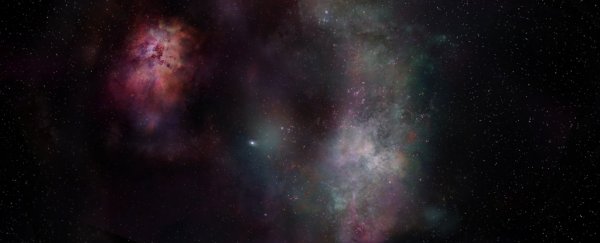Some of the ingredients necessary for life didn't take very long to emerge after the Universe winked into existence.
According to a new analysis of a pair of galaxies at the dawn of time, water was present in the Universe just 780 million years after the Big Bang – when the Universe was just 5 percent of its current age.
This suggests that, even though heavy elements were still relatively scarce, no time was wasted in the creation of molecules.
The galaxies, at least as we see them after their light has traveled 12.88 billion years, are in the process of merging together into one big galaxy, collectively known as SPT0311-58, and they're among the oldest known galaxies in the Universe.
The gravitational disruptions caused by their interactions are thought to be triggering a wave of star formation that's using up all the available molecular gas. But there's still enough gas that astronomers were able to peer into it, obtaining spectral signatures that reveal the presence of certain molecules.
"Using high-resolution ALMA [Atacama Large Millimeter/submillimeter Array] observations of molecular gas in the pair of galaxies known collectively as SPT0311-58 we detected both water and carbon monoxide molecules in the larger of the two galaxies," says astronomer Sreevani Jarugula of the University of Illinois.
"Oxygen and carbon, in particular, are first-generation elements, and in the molecular forms of carbon monoxide and water, they are critical to life as we know it."
Because light from galaxies in the early Universe has traveled so far to reach us, it is very faint, and much more difficult to discern details than it is with galaxies that are relatively close by. However, the interstellar medium in these galaxies is rich with dust, which can help reveal the presence of water.
This dust absorbs the ultraviolet radiation from stars and re-emits it as far-infrared light, the researchers said. This infrared radiation excites water molecules in the interstellar medium, which generates emission that can be detected by a sensitive telescope like ALMA in Chile.
Locating this water at such an early point in the Universe's history can help scientists understand the origin and evolution of the building blocks of life in the Universe.
"This galaxy is the most massive galaxy currently known at high redshift, or the time when the Universe was still very young," Jarugula explains.
"It has more gas and dust compared to other galaxies in the early Universe, which gives us plenty of potential opportunities to observe abundant molecules and to better understand how these life-creating elements impacted the development of the early Universe."
Working out the composition of the molecular clouds from which stars form can help us better understand how much gas there is, the rate at which it is being converted into stars, and how many stars were forming in the early Universe.
This was a time when the rate of star formation could only be described as furious – thousands of times more productive than it is in more recent times, due to the high abundance of dust and gas from which stars could form.
"This study not only provides answers about where, and how far away, water can exist in the Universe but also has given rise to a big question: How has so much gas and dust assembled to form stars and galaxies so early in the Universe?" Jarugula says.
"The answer requires further study of these and similar star-forming galaxies to get a better understanding of the structural formation and evolution of the early Universe."
The research has been published in The Astrophysical Journal.
